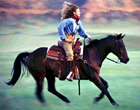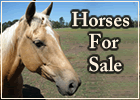

Nipping Horse
Nipping or biting is an aggressive act that is dangerous and disrespectful no matter what the root cause – boredom, playfulness, whatever. The first question to ask yourself is, “Am I doing anything to cause the nipping?” such as feeding treats from your hand or allowing the horse to come into your space and be rewarded for crowding you.
When you feed anything from your hand – treats, carrots, grass, hay, grain, etc., you will destroy your leadership relationship with your horse and be considered by your horse as nothing more than a cookie dispenser. Feeding from the hand causes many unwanted behaviors. All of the horse’s attention and affection will be focused on the cookie. These are beautiful qualities that I want focused on me as my horse’s partner and leader.
A horse fed from the hand will literally mug you for his cookie as if he is saying, “Where’s my cookie? Give me my cookie? Is it in this hand? Is it in this pocket?” I never feed anything from my hand; in fact I don’t want to be associated with food in any way. I would rather my horse just find his feed rather than see me bring it to his bucket. I want to be the “treat” for my horse by spending lots of friendly time bonding with him, rubbing and grooming so he gets the idea that life is good with me.
One of my “written in stone” rules is that the horse is never allowed to touch me with any part of his body at any time. “Touch me” means coming within arm’s length of me. I want my horse to know that if he crowds into my space he will find that my personal space is a very uncomfortable place to be. He would not want to crowd a porcupine so think of your space as a porcupine. This does not mean I don’t love on and rub my horse. I do plenty of loving on my horse but I do it in his space on my terms, not the other way around. He doesn’t barge into me or crowd my space and get rewarded by being rubbed. Instead I drive him out of my space with rhythmic pressure by creating a commotion with my arms, elbows, rope, etc. then I go into his space to rub on him.
I see horses rubbing people with their head, jaw or neck and the person says, “Oh, isn’t that cute. My horse loves me!” This is actually more a sign of disrespect than love. The horse has an itch and thinks of you as a fence post that he can scratch on. That same horse would not even consider going up to the herd leader and scratching himself on that horse. The herd leader is to be respected at all times and will make his boundaries clearly and quickly known to any horse that comes too close. You should have this same air of confident leadership and well established boundaries.
Along with what I’ve described above here is a plan to deal with a nipping horse:
- Awareness and positioning- When I am with any horse I am always aware of my position relative to their nose. I want the nose to stay straight ahead in a neutral position. If I let the nose swing over into my space then for all practical purposes the horse has already bitten me. I use the backing exercise, rhythmic open palms or elbows, jumping jacks or waving a rope or crop to place the horse at a respectful distance from me. I insist on respect for my space at all times with every horse so I remove their temptation to nose around on me.
- Attention- With a horse who really wants to have his nose in my space, I’ll drive him outside my space then go into his space and pay him lots of loving attention with both hands all around his head, stroking his cheeks, forelock, lips, nostrils, ears. I want to make sure I am meeting his needs for attention.
- More Attention- When I step away if he moves his nose towards me I will give his nose more attention than he really wanted by rubbing his nose quickly but gently until he chooses to move his nose away. When he does I leave him alone. If his nose comes back into my space again I greet it with extra enthusiasm. After a few times repeating this process he will decide to leave his nose out of my space.
- Get him busy- If he starts doing anything I don't like I will back him, circle him or do any of the other exercises until he settles and stands quietly.
Horses don't bite people they respect so work at establishing your solid relationship and leadership position with him.

Ed Dabney is an internationally acclaimed clinician, presenting horsemanship and riding clinics all over the US and in Europe. In 2007, Ed was named Champion of the East Coast Trainer Challenge Series by Equine Extravaganza. Ed was honored to have been selected by the University of Georgia to teach their senior level Young Horse Training course.
His training articles have appeared in many major national magazines. Ed produces instructional videos and the “Gentle Horsemanship” TV program which has been seen on RFD-TV.
Ed's blending of natural horsemanship and classical equitation has made an indelible mark with students all across the United States and now also in Europe, drawing the attention of serious riders searching for the lightest touch and the deepest connection with their horses irrespective of breed or discipline.


